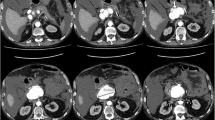Abstract
Purpose
The aim of this study was to analyse our 8 years of experience with endovascular treatment of visceral aneurysms and pseudoaneurysms.
Materials and methods
From January 2002 to September 2009, we used an endovascular approach to treat 30 patients (22 men, eight women) affected by aneurysm (n=18) or pseudoaneurysm (n=13) of the splenic (n=11), hepatic (n=6), renal (n=5), pancreaticoduodenal (n=3), left gastric (n=2), gastroduodenal (n=1), rectal (n=1) or middle colic (n=1) arteries and the coeliac axis (n=1). Of these, 26/31 were treated with metal coils, 3/31 with Cardiatis multilayer stent, 1/31 with a coated stent and 1/31 with coils and Amplatzer plug. Procedures were performed electively in 10/30 cases and during haemorrhage in 20/30 cases. Follow-up was performed clinically (cessation of bleeding) and at 1, 6 and 12 months by colour-Doppler ultrasound (CDUS) and computed tomography (CT) angiography.
Results
In 31/31 aneurysms and pseudoaneurysms we obtained immediate exclusion. In four patients with aneurysm and in four with pseudoaneurysm, parenchymal ischaemia occurred; one was treated with surgical splenectomy. One patient with pseudoaneurysm of the coeliac axis died 10 days later because of new bleeding. During follow-up, all aneurysms and pseudoaneurysms remained excluded.
Conclusions
Percutaneous treatment is effective and safe, with a small number of complications, especially when compared with traditional surgery.
Riassunto
Obiettivo
Scopo dello studio è analizzare 8 anni della nostra esperienza nel trattamento endovascolare di aneurismi e pseudoaneurismi viscerali.
Materiali e metodi
Da gennaio 2002 a settembre 2009 sono stati trattati con terapia endovascolare 30 pazienti (22 maschi, 8 femmine) portatori di aneurismi (n=18) o pseudoaneurismi (n=13) originanti dall’arteria splenica (n=11), epatica (n=6), renale (n=5), pancreaticoduodenale (n=3), gastrica sinistra (n=2), gastroduodenale (n=1), rettale (n=1), colica media (n=1) e dal tripode celiaco (n=1). Ventisei/31 sono stati trattati con spirali metalliche, 3/31 con stent multimaglia Cardiatis, 1/31 con spirali e Amplatzer plug, 1/31 con stent ricoperto. Dieci/30 procedure sono state effettuate in elezione, 20/30 durante sanguinamento. Il follow-up è stato eseguito clinicamente (cessazione del sanguinamento) e a 1, 6 e 12 mesi (eco-color Doppler ed angio-tomografia computerizzata).
Risultati
In 31/31 degli aneurismi e pseudoaneurismi trattati si è ottenuta esclusione immediata. In 4 pazienti portatori di aneurisma e in 4 portatori di pseudoaneurisma si è verificata ischemia parenchimale; in un caso si è ricorso a splenectomia. Un paziente portatore di pseudoaneurisma del tripode celiaco è deceduto dopo 10 giorni per nuovo sanguinamento. Durante il follow-up tutti gli aneurismi sono rimasti esclusi.
Conclusioni
Il trattamento percutaneo risulta efficace e sicuro con ridotto numero di complicanze se paragonato al tradizionale intervento chirurgico.
Similar content being viewed by others
References/Bibliografia
Perez-Vallecillos P, Conde-Muìo R, Segura-Jiménez I et al (2010) Acute retroperitoneal bleeding due to inferior mesenteric artery aneurysm: Case report. BMC Gatroenterol 10:59
Sachdev-Ost U (2010) Visceral artery aneurysm: review of current management options. Mt Sinai J Med 77:296–303
Ferrero E, Gaggiano A, Ferri M et al (2010) Visceral artery aneurysm: series of 17 cases treated in a single center. Int Angiol 29:30–36
Baert AL, Sartor K (2006) Vascular embolotherapy. Springer, Berlin Heidelberg New York
Ruiter-Derksen GL, Bruijnen RCG, Joosten F, Reijnen MMPJ (2010) Endovascular treatment of a hepatic artery aneurysm causing chronic abdominal pain; a case report. Ann Hepatol 1:104–106
Pulli R, Dorigo W, Troisi N et al (2008) Surgical treatment of visceral artery aneurysm: a 25-year experience. J Vasc Surg 48:334–342
Lookstein RA, Guller J (2004) Embolization of complex vascular lesions. Mt Sinai J Med 71:17–28
Ceppa EP, Evans DC, Upton EC et al (2008) Endovascular treatment of a traumatic visceral aneurysm. J Trauma 65:929–932
Aune S (2008) Surgery of visceral arteries. Tidsskr Nor Laegeforen 128:2320–2322
Nosher JL, Chung J, Brevetti LS et al (2006) Visceral and renal artery aneurysms: a pictorial essay on endovascular therapy. Radiographics 26:1687–1704
Carmo M, Mercandalli G, Rampoldi A et al (2008) Transcatheter thrombin embolization of a giant visceral artery aneurysm. J Cardiovasc Surg 49:777–782
Rossi M, Rebonato A, Greco L et al (2008) Endovascular exclusion of visceral artery aneurysm with stent-grafts: technique and log-term follow-up. Cardiovasc Intervent Radiol 31:36–42
Balderi A, Antonietti A, Pedrazzini F et al (2010) Management of hepatic artery aneurysm by endovascular exclusion using multilayer Cardiatis stent. Cardiovasc Intervent Radiol 33:1282–1286
Tulsyan N, Kashyap VS, Greenberg RK et al (2007) The endovascular management of visceral artery aneurysms and pseudoaneurysms. J Vasc Surg 45:276–283
Ruiz-Tovar J, Martinez-Molina E, Morales V et al (2007) Evolution of therapeutic approach of visceral aneurysms. Scand J Surg 96:308–313
Sadat U, Noor N, Tang T, Varty K (2007) Emergency endovascular repair of ruptured visceral artery aneurysms. WJ Emerg Surg 2:17
Messina LM, Shanley CJ (1997) Visceral artery aneurysms. Surg Clin North Am 77:425–442
Mattar SG, Lumsden AB (1995) The management of splenic artery aneurysms: experience with 23 cases. Am J Surg 169:580–584
Dave B, Sharma A, Kwolek C et al (2010) Percutaneous transcatheter embolization of pancreatico-duodenal artery aneurysms associated with celiac artery stenosis or occlusion. Catheter Cardiovasc Interv 75:663–672
Author information
Authors and Affiliations
Corresponding author
Rights and permissions
About this article
Cite this article
Balderi, A., Antonietti, A., Ferro, L. et al. Endovascular treatment of visceral artery aneurysms and pseudoaneurysms: our experience. Radiol med 117, 815–830 (2012). https://doi.org/10.1007/s11547-011-0776-4
Received:
Accepted:
Published:
Issue Date:
DOI: https://doi.org/10.1007/s11547-011-0776-4




